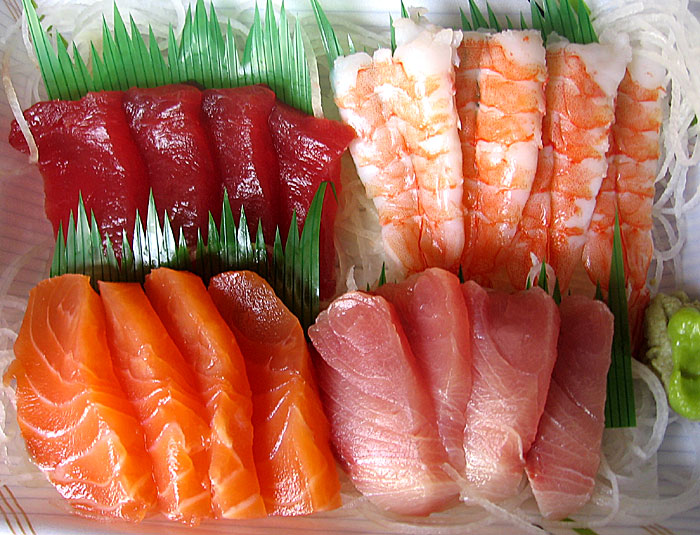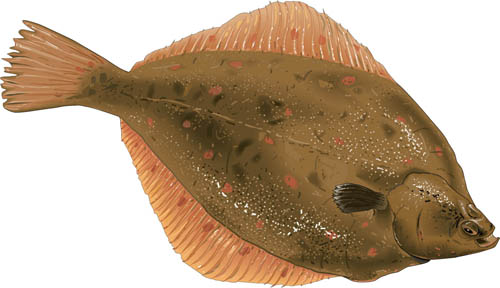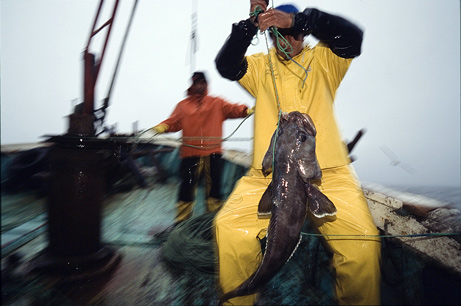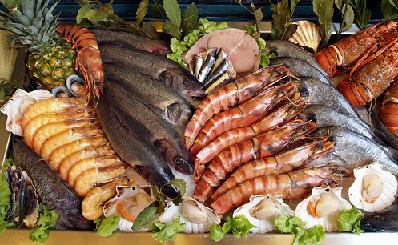Yes fish, no fish, red fish…OK fish? Sometimes deciphering all the seafood recommendations out there can feel a bit like the old Dr. Seuss tale. But the nonprofit Food and Water Watch has just released a seafood guide that it hopes will make it a little easier. “When people find out we work on seafood, the consistent question we get is, What should I eat?” says Marianne Cufone, director of the Fish Program at Food and Water Watch, and one of the researchers of the group’s new guide. “Some people choose certain fish because they’re more nutritious, others because they have a specific cultural meaning. It’s really hard to tell someone what they should or should not eat.” So the group compiled a list of the good, the bad, and the absolute worst fish, based on a wider variety of criteria than some of the other seafood lists out there.
Specifically, the researchers looked at problems of overfishing, how certain breeds are farmed, and levels of toxic contaminants like mercury or PCBs in the fish, as well as how heavily local fishermen relied upon fisheries for their economic survival. After several years of researching fisheries worldwide, they came up with a comprehensive list of the best fish to eat, which to avoid, and recommendations for alternatives. As it did its research, the group came up with a list of the 12 fish and seafood types you should never eat—and some are a lot more common on our plates than may be wise.
#1: Imported Catfish. Nearly 90 percent of the catfish imported to the U.S. comes from Vietnam, where use of antibiotics that are banned in the U.S. is widespread. Furthermore, the two varieties of Vietnamese catfish sold in the U.S., Swai and Basa, aren’t technically considered catfish by the federal government and therefore aren’t held to the same inspection rules that other imported catfish are.
Eat this instead: Stick with domestic, farm-raised catfish, advises Cufone. It’s responsibly farmed and plentiful, making it one of the best fish you can eat.
#2: Caviar. Caviar from beluga and wild-caught sturgeon are susceptible to overfishing, according to the Food and Water Watch report, but the species are also being threatened by an increase in dam building that pollutes the water in which they live. All forms of caviar come from fish that take a long time to mature, which means that it takes a while for populations to rebound.
Eat this instead: If you really love caviar, opt for fish eggs from American Lake Sturgeon or American Hackleback/Shovelnose Sturgeon caviar from the Mississippi River system.
#3: Atlantic Cod. This one was difficult to add to the “dirty dozen list,” says Cufone, because it is so vital to the economic health of New England fishermen. “However, chronic mismanagement by the National Marine Fisheries Service and low stock status made it very difficult to recommend,” she says. Atlantic cod stocks collapsed in the mid-1990s and are in such disarray that the species is now listed as one step above endangered on the International Union for Conservation of Nature’s Red List of Threatened Species.
Eat this instead: The good news, if you love fish ‘n’ chips, is that Pacific cod stocks are still strong and are one of Food and Water Watch’s best fish picks.
#4: American Eel. Also called yellow or silver eel, this fish, which frequently winds up in sushi dishes, made its way onto the list because it’s highly contaminated with PCBs and mercury. The fisheries are also suffering from some pollution and overharvesting.
Eat this instead: If you like the taste of eel, opt for Atlantic- or Pacific-caught squid instead.
#5: Atlantic Flatfish. This group of fish includes flounder, sole, and halibut that are caught off the Atlantic coast. They found their way onto the list because of heavy contamination and overfishing that dates back to the 1800s. According to Food and Water Watch, populations of these fish are as low as 1 percent of what’s necessary to be considered sustainable for long-term fishing.
Eat this instead: Pacific halibut seems to be doing well, but the group also recommends replacing these fish with other mild-flavored white-fleshed fish, such as domestically farmed catfish or tilapia.
#6: Imported King Crab. The biggest problem with imported crab is that most of it comes from Russia, where limits on fish harvests aren’t strongly enforced. But this crab also suffers from something of an identity crisis, says Cufone: “Imported king crab is often misnamed Alaskan king crab, because most people think that’s name of the crab,” she says, adding that she’s often seen labels at supermarkets that say “Alaskan King Crab, Imported.” Alaskan king crab is a completely separate animal, she says, and it’s much more responsibly harvested than the imported stuff.
Eat this instead: When you shop for king crab, whatever the label says, ask whether it comes from Alaska or if it’s imported. Approximately 70 percent of the king crab sold in the U.S. is imported, so it’s important to make that distinction and go domestic.
#7: Imported Shrimp. Imported shrimp actually holds the designation of being the dirtiest of the Dirty Dozen, says Cufone. Even before the BP oil leak in the Gulf of Mexico, 90 percent of shrimp sold in the U.S. was imported, she says. “Imported farmed shrimp comes with a whole bevy of contaminants: antibiotics, residues from chemicals used to clean pens, filth like mouse hair, rat hair, and pieces of insects,” Cufone says. “And I didn’t even mention things like E. coli that have been detected in imported shrimp.”Part of this has to do with the fact that less than 2 percent of ALL imported seafood (shrimp, crab, catfish, or others) gets inspected before its sold, which is why it’s that much more important to buy domestic seafood.
Eat this instead: Look for domestic shrimp. Unfortunately, 70 percent of domestic shrimp comes from the Gulf of Mexico, and the recent oil spill may have long-term impacts on its shrimp stocks. But Cufone says that shrimp can be purchased from Texas, the East Coast, Maine, and the Carolinas, so you still have options.
#8: Orange Roughy. In addition to having high levels of mercury, orange roughy can take between 20 and 40 years to reach full maturity and reproduces late in life, which makes it difficult for populations to recover from over fishing. Orange roughy has such a reputation for being overharvested that some large restaurant chains, including Red Lobster, refuse to serve it. However, it still pops up in grocer freezers, sometimes mislabeled as “sustainably harvested.” There are no fisheries of orange roughy that are considered well-managed or are certified by the Marine Stewardship Council, which tracks sustainable seafood, so avoid any that you see.
Eat this instead: Opt for yellow snapper or domestic catfish to get the same texture as orange roughy in your recipes.
#9: Atlantic Salmon (both wild-caught and farmed). It’s actually illegal to capture wild Atlantic salmon because the fish stocks are so low, and they’re low, in part, because of farmed salmon. Salmon farming is very polluting: Thousands of fish are crammed into pens, which leads to the growth of diseases and parasites that require antibiotics and pesticides. Often, the fish escape and compete with native fish for food, leading to declines in native populations. Adding to our salmon woes, the U.S. Food and Drug Administration is considering allowing genetically engineered salmon to be sold, unlabeled, to unsuspecting seafood lovers. That salmon would be farmed off the coast of Panama, and it’s unclear how it would be labeled. Currently, all fish labeled “Atlantic salmon” come from fish farms.
Eat this instead: Opt for wild Alaskan salmon now.
#10: Shark. Problems associated with our eating too many sharks happen at all stages of the food chain, says Cufone. For one, these predatory fish are extremely high in mercury, which poses threats to humans. But ocean ecosystems suffer, too. “With fewer sharks around, the species they eat, like cownose rays, have increased in numbers,” Cufone says. “And the rays are eating—and depleting—scallops and other fish.” There are fewer of those fish in the oceans for us to eat, placing an economic strain on coastal communities that depend on those fisheries.
Eat this instead: Among the recommendations for shark alternatives are Pacific halibut and Atlantic mackerel.
#11: Chilean Sea Bass. Most Chilean sea bass sold in the U.S. comes from fishermen who have captured them illegally, although the U.S. Department of State says that illegal harvesting of the fish has declined in recent years. Nevertheless, fish stocks are in such bad shape that the nonprofit Greenpeace estimates that, unless people stop eating this fish, the entire species could be commercially extinct within five years. Food and Water Watch’s guide notes that these fish are high in mercury, as well.
Eat this instead: These fish are very popular and considered a delicacy, but you can get the same texture and feel with U.S. hook-and-line–caught haddock.
#12: Atlantic Bluefin Tuna. A recent analysis by The New York Times found that Atlantic bluefin tuna has the highest levels of mercury of any type of tuna. To top it off, bluefin tuna are severely overharvested, to the point of reaching near-extinction levels, and are considered “critically endangered” by the International Union for Conservation of Nature. Rather than trying to navigate the ever-changing recommendations for which tuna is best, consider giving it up altogether and switching to a healthy, flavorful alternative, such as Alaska wild-caught salmon.
Eat this instead: If you really can’t give up tuna, opt for American or Canadian (but not imported!) albacore tuna, which is caught while it’s young and doesn’t contain as high levels of mercury.
What’s a health-conscious fish eater to do? The Monterey Bay State Aquarium’s seafood watch website can help you sift through dozens and dozens of options, and even offers a pocket guide you can print out. But for times when you’re caught without that data, here’s a simple list of the healthiest fish to keep in your head:
1. Albacore Tuna (Canada, U.S.)
2. Arctic Char (farmed)
3. Atlantic Mackerel
4. Rainbow Trout (farmed)
5. Sablefish/Black Cod (Alaska, Canada)
6. Sardines (U.S.)
7. Wild Salmon (Alaska)
The Monterey Bay Aquarium and EPA have rated these as the most healthful—not just for you, but for the ocean, too. All are high in heart-healthy omega-3s and low in contaminants, and are fish whose fishing or farming methods have minor impacts on the environment.
3 Unexpected Ways the Fish Aisle Could Sicken You
It’s no secret that mercury in fish is bad for your health. Ill effects ranging from low IQ, ADHD, and autism in children have been well documented, but emerging research suggests that eating too many meals of tainted fish could lead to other common, yet unexpected, diseases in adults, too.
Could lupus and rheumatoid arthritis be fueled by mercury-infused fish? A new study published in the journal Environmental International suggests that just might be the case. Researchers looked at a large group of women and discovered that higher levels of mercury in the body correlated to higher thyroid antibodies. These thyroid antibodies are most notably elevated in women who live with autoimmune diseases like lupus and rheumatoid arthritis, painful conditions in which the immune system starts attacking healthy tissue.
Mercury, a heavy metal, has been shown to accumulate in the human thyroid gland, but experts say more research is needed to figure out exactly how mercury affects the thyroid and alters our ability to be healthy. Until that happens, if you eat fish, seek out species that are lower in mercury buildup—current “safe” levels may be too high—and high in omega 3s to boost your health. “This study suggests the possibility of risks at levels of mercury in the blood below what is currently considered safe,” says study author Carolyn Gallagher, PhD candidate in the department of preventive medicine at Stony Brook University in New York.
Heart Attacks
Mercury in fish could mean bad news for your ticker, too. Although many fish are packed with heart-disease-fighting omega-3 fatty acids, mercury contamination could cancel out that benefit and even increase your risk of suffering a heart attack. A 2012 study from Syracuse University found that high mercury levels in fish could throw off your body’s natural response to stress, increasing inflammation, a leading cause of heart disease.
Interestingly, even levels of mercury considered “safe” caused an unnatural change in cortisol levels. Although cortisol is considered a stress hormone, its natural ebb and flow throughout the day helps protect against inflammation. When mercury blunts cortisol levels in the body, inflammation—and heart disease—can flourish. Children who have routinely depressed cortisol could face an increased risk of heart problems as they age.
Eczema
Mercury in a pregnant or nursing mother’s diet may not only affect her child’s IQ, but also could create a predisposition for childhood eczema, according to a 2010 study published in the journal Environmental Health Perspectives.
Eczema an itchy skin allergy characterized by an irritating, red raised rash, is more common in children whose mothers ate a diet higher in mercury while breastfeeding, and in children with higher levels of mercury in their systems.
Here’s what you need to know about choosing safer seafood.
• Look for the right tuna. Tuna is rich in healthful omega-3 fats, but some species are endangered, are high in mercury, or both. However, experts have found that albacore tuna caught in waters off the western coasts of the U.S. and Canada is lower in contaminants. Greenpeace named Wild Planet Foods’ albacore tuna No. 1 in terms of sustainability; the tuna is also much lower in mercury compared to other brands.
• Know your supplements. Some fish-oil supplements will list the source of the oil on the label. Choose brands that use smaller fish, such as sardines, anchovies, or mackerel, as the oil source; this will reduce your contamination (smaller fish are lower on the food chain, thus less contaminated).
• Avoid heavily tainted species. Salmon seems like a good choice for low contamination and high omega-3 content, but be sure to steer clear of unsustainable, often-tainted farmed salmon. To satisfy your salmon fix, choose wild-caught Alaskan salmon. The population is stable and tends to be lower in contaminants.
Source Article from https://worldtruth.tv/everything-you-need-to-know-about-fish-and-seafood/
 RSS Feed
RSS Feed















 June 9th, 2017
June 9th, 2017  Awake Goy
Awake Goy 






















 Posted in
Posted in  Tags:
Tags: 













